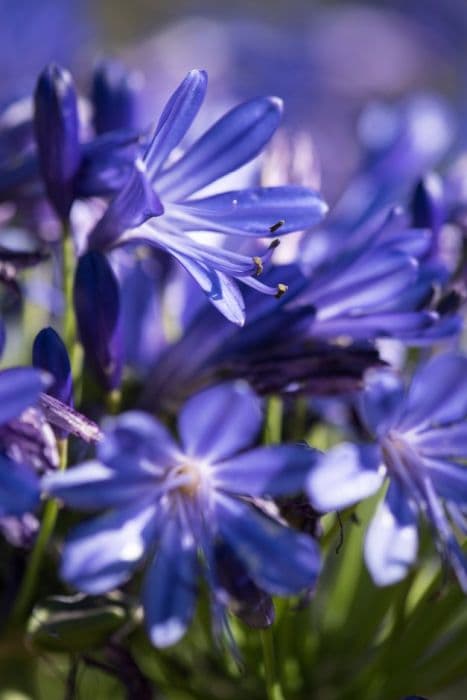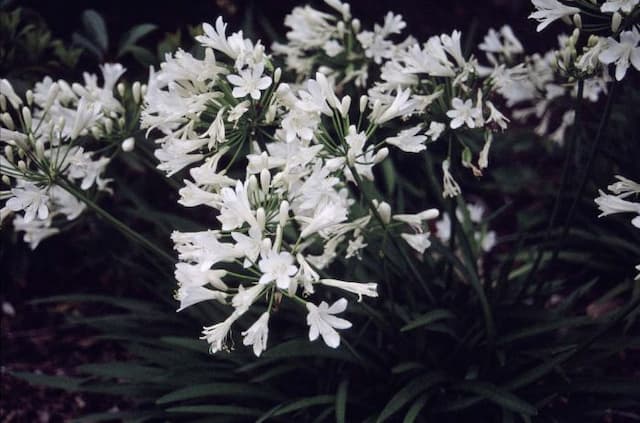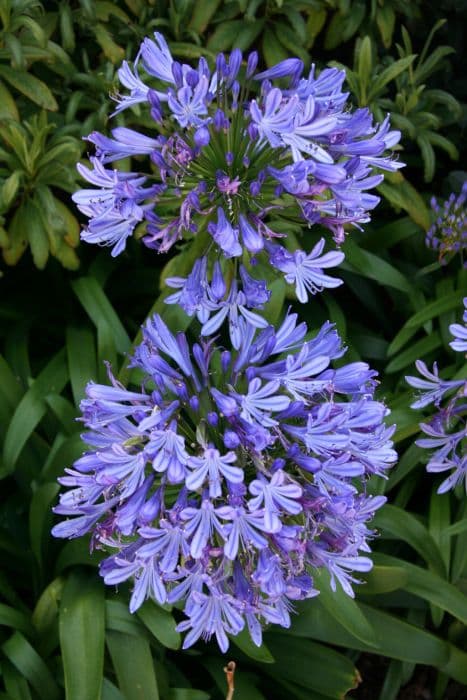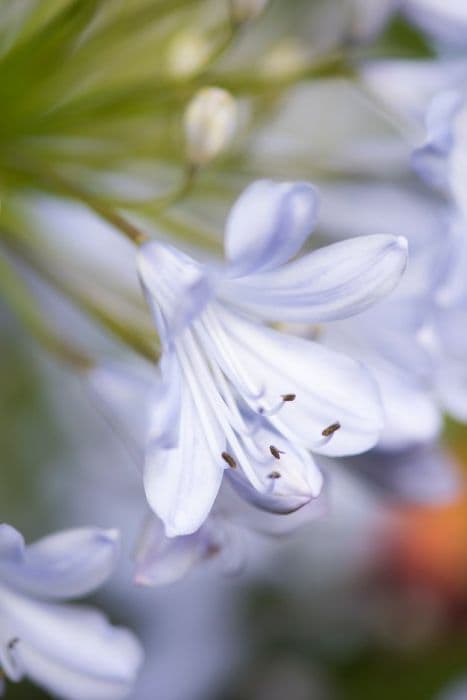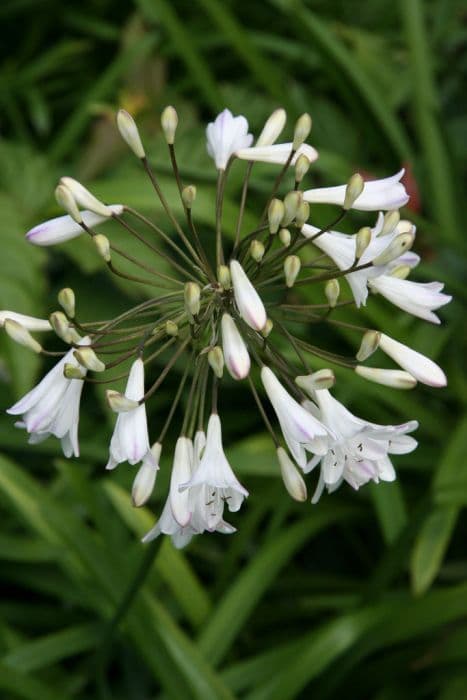African lily 'Indigo Dreams' Agapanthus 'Indigo Dreams'

ABOUT
'Indigo Dreams' is a herbaceous perennial 70cm high with deciduous, narrow, strap-shaped green leaves and many small round heads of very dark indigo-blue flowers in late summer
About this plant
 Names
NamesFamily
Amaryllidaceae
Synonyms
African Lily, Lily of the Nile
Common names
Agapanthus 'Indigo Dreams'.
 Characteristics
CharacteristicsLife cycle
Perennials
Foliage type
Evergreen
Color of leaves
Green
Flower color
Indigo
Height
2 feet [60 cm]
Spread
2 feet [60 cm]
Plant type
Bulb
Hardiness zones
8
Native area
South Africa
Benefits
 General Benefits
General Benefits- Attractive blooms: Agapanthus 'Indigo Dreams', commonly known as African Lily, produces deep blue to purple flowers that add a vibrant splash of color to any garden.
- Drought tolerance: Once established, African Lily is quite tolerant to drought, making it suitable for water-wise gardens.
- Low maintenance: This plant requires minimal care beyond the initial establishment period, making it ideal for gardeners looking for low-maintenance options.
- Attracts pollinators: The striking flowers of the African Lily attract bees, butterflies, and other pollinating insects, promoting biodiversity.
- Long blooming season: Agapanthus 'Indigo Dreams' has a long flowering period that often lasts from early summer to fall, providing extended interest in the garden.
- Architectural form: With its strappy leaves and tall flower stems, African Lily contributes an architectural element to garden design.
- Versatility: This plant is versatile and can be used in borders, containers, or as a focal point in the landscape.
- Deer resistance: African Lily is known to be resistant to deer, which can be beneficial in areas where deer browse is a common problem.
- Easy to propagate: African Lily can be easily propagated by dividing clumps, making it simple to increase your stock or share with other gardeners.
- Long-lived: As a perennial, Agapanthus 'Indigo Dreams' can live for many years, providing long-term enjoyment with proper care.
 Medical Properties
Medical PropertiesThis plant is not used for medical purposes.
 Air-purifying Qualities
Air-purifying QualitiesThis plant is not specifically known for air purifying qualities.
 Other Uses
Other Uses- Artistic Inspiration: Agapanthus 'Indigo Dreams' vibrant blue-violet flowers can serve as a muse for artists and can be seen depicted in a variety of paintings and drawings.
- Dye Source: The deep blue color of the flowers can be used to create natural dyes for fabrics or inks.
- Floral Arrangements: The tall and striking appearance of the Agapanthus flowers makes them popular in bouquets and ornamental floral arrangements.
- Garden Borders: Because of their clumping nature, they can provide a lush border that defines garden spaces and paths.
- Photography Subjects: Due to their striking appearance, they are often used by photographers seeking to capture the beauty of nature in their work.
- Educational Tool: Botany enthusiasts may use Agapanthus 'Indigo Dreams' to study plant structure and growth patterns in a garden setting.
- Theme Gardens: These plants are sometimes used to create monochromatic or cool-toned color schemes in themed gardens.
- Wedding Decor: Fresh or dried, they are selected for wedding decorations to add a natural and elegant touch to ceremonies.
- Culinary Presentation: Non-toxic varieties of Agapanthus can occasionally garnish plates or be used as an edible decoration on desserts for visual enhancement, provided they're confirmed safe to come into contact with food.
- Potpourri Ingredient: The dried petals can contribute to the color and texture of homemade potpourri mixes, offering a hint of floral elegance to home decor.
Interesting Facts
 Feng Shui
Feng ShuiThe Lily of the Nile is not used in Feng Shui practice.
 Zodiac Sign Compitability
Zodiac Sign CompitabilityThe Lily of the Nile is not used in astrology practice.
 Plant Symbolism
Plant Symbolism- Love Letters: The genus name Agapanthus comes from the Greek words 'agape', meaning love, and 'anthos', meaning flower. Therefore, it's often associated with love and can symbolize a love letter or a message from the heart.
- Enduring Love: Agapanthus, commonly known as African Lily, is a symbol of enduring and secret love. This symbolism comes from the plant's perennial nature, as it returns each year to bloom again.
- Beauty: With its striking blue-violet flowers, 'Indigo Dreams' represents beauty, indicating an appreciation of the visual aesthetics and uniqueness.
- Survival: African Lily is a hardy plant that can survive with minimal care in challenging environments. This characteristic allows it to symbolize survival, resilience, and strength.
- Fertility: In some cultures, the lush foliage and rounded flower clusters of the African Lily can symbolize fertility and abundance.
- Freedom: The African Lily's tall and free-blooming nature gives it an air of wildness and freedom, often representing the idea of liberation or an open spirit.
 Water
WaterThe Lily of the Nile (Agapanthus 'Indigo Dreams') should be watered generously every week or two, ensuring that the soil is moist but not waterlogged. During the growing season, it may require more frequent watering, especially in hotter, dryer climates. Provide about one to one and a half gallons of water for outdoor plants, ensuring that the water penetrates deeply into the soil. Reduce watering in the winter when the plant is dormant, possibly to every two to three weeks depending on the climate. Always check the soil moisture before watering to avoid overwatering which can lead to root rot.
 Light
LightLily of the Nile thrives best in full sun to partial shade. It should be placed in a spot where it receives at least six hours of sunlight daily. Morning sunlight and afternoon shade are ideal for this plant, especially in hotter climates to prevent the leaves from getting scorched. Avoid deep shade as it can result in fewer blooms and weaker growth.
 Temperature
TemperatureLily of the Nile can tolerate a range of temperatures but grows best when daytime temperatures are between 70 to 80 degrees Fahrenheit. It can survive minimum temperatures down to about 50 degrees Fahrenheit, but frost can damage the foliage and flowers. The ideal temperature range for promoting good growth and flowering is 60 to 70 degrees Fahrenheit at night and 70 to 80 degrees Fahrenheit during the day.
 Pruning
PruningFor the Lily of the Nile, pruning is generally done to remove spent flower stalks and to tidy up any dead or damaged foliage. Pruning can be done after flowering, usually in late summer or fall. Cut the flower stalks down at the base, but be careful not to cut new shoots. Regularly removing the dead leaves will help encourage healthy growth and can be done as needed throughout the year.
 Cleaning
CleaningAs needed
 Soil
SoilFor African Lily 'Indigo Dreams,' use a well-draining soil mix with loam and sand or perlite; aim for a pH between 6.0 and 8.0 for optimal growth.
 Repotting
RepottingAfrican Lily 'Indigo Dreams' should be repotted every 2-3 years or when it becomes root-bound to encourage continued growth.
 Humidity & Misting
Humidity & MistingAfrican Lily 'Indigo Dreams' thrives best in moderate humidity levels but is quite adaptable and can tolerate the humidity levels typically found in most homes.
 Suitable locations
Suitable locationsIndoor
Ensure bright light, well-draining soil for indoor African Lily growth.
Outdoor
Place in sunny spot, well-drained soil, protect from harsh winter.
Hardiness zone
8-10 USDA
 Life cycle
Life cycleThe Lily of the Nile 'Indigo Dreams' starts its life cycle as a seed, which, when sown in a well-drained soil mix, will germinate given warm temperatures and consistent moisture. After the seedlings emerge, they grow into juvenile plants with slender, strap-like foliage. As the plants mature, they develop into clumps of evergreen foliage and eventually produce sturdy, elongated stems that bear spherical clusters of trumpet-shaped, deep blue or indigo flowers, typically in summer. After the blooming period, the flowers fade and seed pods may form, which can be harvested for propagation or left to self-seed in suitable climates. The plant's foliage continues to photosynthesize and store energy in the underground rhizomes, allowing it to perennialize and re-emerge the following season. Over time, the clumps can become crowded and may require division to rejuvenate the plant and encourage more prolific flowering.
 Propogation
PropogationPropogation time
Spring-Early Summer
Propogation: Agapanthus 'Indigo Dreams', commonly known as African Lily, is best propagated through division, which is typically performed in the spring or early fall to allow the plant enough time to establish before the onset of winter. To propagate by division, carefully lift the entire clump from the ground and gently separate it into smaller clumps, ensuring each new section has at least one growing point or fan of leaves attached. Replant these divisions immediately, maintaining the original planting depth, and water them thoroughly. This method allows gardeners to quickly increase their stock of Agapanthus 'Indigo Dreams' while preserving the genetic traits of the parent plant.
